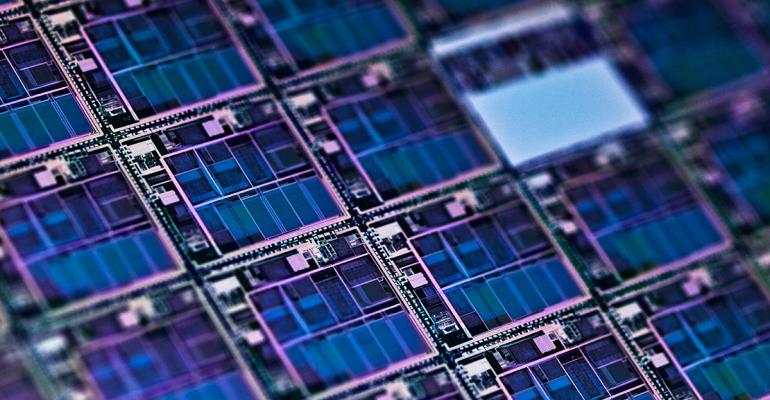(The Washington Post) -- As Washington revs up for an election year, the obscure field of semiconductors is shaping up to be front and center in President Biden's economic policy.
Semiconductors, or "chips," usually exist quietly, serving as the brains inside everything from smartphones to self-guided missiles. The average voter probably thinks about them rarely, if ever. But chips are having their moment, with the Biden administration identifying them as key to its plans to create jobs, revitalize US manufacturing, and cement US technological leadership over rivals like China.
The administration recently began rolling out $52 billion in subsidies to boost the US semiconductor industry, in a program called "CHIPS for America." Voters can expect to hear a steady drumbeat about the program in coming months, as Biden makes the argument that he's succeeded in shoring up the nation's economy and creating high-tech jobs.
The latest move under the CHIPS program is the establishment of a national, nonprofit semiconductor research center under the auspices of the Commerce Department, with a dotted line to the Defense Department. The National Center for the Advancement of Semiconductor Technology - nicknamed "Natcast" - is expected to announce Tuesday that Deirdre Hanford, chief security officer of Sunnyvale, California-based chipmaking tool supplier Synopsys, will begin as the first chief executive on Feb. 1, kicking off the center's work.
Commerce Secretary Gina Raimondo said in a statement that the new research center was the "centerpiece" of efforts to build a strong semiconductor R&D ecosystem, "which will enable the United States to be the world's technological superpower and advance our economic security."
In a throwback to an earlier era of a heavier government hand in industry, Natcast will have the ambitious mission of coordinating semiconductor research and development across companies and universities to try to ensure the US retains leadership in next-generation chip technologies - and that China, in particular, does not catch up. Natcast will initially be funded by the Commerce Department. Details of its budget, staff size and specific goals have yet to be announced.
"Semiconductors are at the heart of the economy, impacting every aspect of our lives," Hanford said in a statement. "I look forward to fulfilling the... mission of fostering semiconductor innovation and growing a talented workforce."
The establishment of Natcast amid concerns about the rise of China's chip industry has parallels to a similar government effort called Sematech in 1987 that came in response to fears of Japan's growing chips prowess.
Funded by the Defense Advanced Research Projects Agency, the Pentagon research unit known as DARPA, Sematech was a not-for-profit consortium between the US government and US chipmaking companies that sought to accelerate the domestic chip research and development process. Sematech succeeded in its early goals, like shortening the amount of time it took for companies to develop even smaller chips, but struggled with its purpose in ensuing years. It last received government funding in 1997 and was absorbed by SUNY Polytechnic Institute in 2015.
Mike Splinter, chair of the Commerce Department's Industrial Advisory Committee, which advised on the setup of Natcast, said in an interview that Natcast has broader goals than Sematech did.
"I think this objective, establishing and extending R&D leadership in the US, is a broad and long-lasting objective that will challenge people for years and maybe generations to come," he said.
Splinter said that there has been growing interest among Washington policymakers in bolstering the US chip manufacturing industry since the mid-2010s, as China began pouring investment into its chipmakers in an effort to catch up. The US government wants to ensure a chip supply chain that would not be disrupted by geopolitics, especially for the military.
John Neuffer, chief executive of the Semiconductor Industry Association, a lobbying group representing US chipmakers, praised Hanford's selection, predicting that her leadership style and experience in Washington policy circles would be assets for the new center as awareness is rising among consumers of the importance of chips to the economy. During the pandemic, a shortage of chips cut manufacturers' ability to produce a wide variety of items, from cars to household appliances.
"My neighbors of 23 years had no interest in what I did," Neuffer recalled. "But when the pandemic struck and the shortages, and refrigerators were hard to buy, my neighbors were coming over and saying, 'Hey, did you do something to do with semiconductors? Can you fix that for me?'"
The Commerce Department has announced two grants to individual companies so far under the CHIPS Act, with Arizona-based Microchip Technology receiving $162 million, and the US subsidiary of European defense contractor BAE Systems receiving $35 million. Officials say that larger awards to other companies will be announced in the coming months.
Chris Miller, a professor at Tufts University and author of the book "Chip War," said that European public-private organizations like Belgium-based IMEC also served as a model for how Natcast could operate, though it remained to be seen how Natcast avoids duplicating existing organizations' functions.
"I think one of the challenges," he said, "is how does it interact with the existing ecosystem so that it's not duplicating or competing, but rather adding on in a new way."





